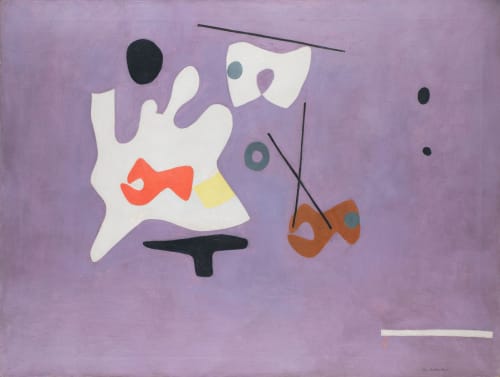I saw in this art a medium for the American painter to exceed the past.
—Solomon R. Guggenheim
Weinstein Gallery is proud to present Making the Museum of Non-Objective Painting: The
Birth of the Guggenheim, opening on the 78th anniversary of the museum’s founding on June 1, 2016 and running through June 30, 2017. This exhibition includes rarely seen masterpieces from sixteen of the original artists represented in Solomon Guggenheim's founding collection and chronicles the rise and development of non-objective painting, spanning from 1916 to 1951.
San Francisco, CA—Weinstein Gallery is proud to present Making the Museum of Non-Objective Painting: The Birth of the Guggenheim, opening on the 78th anniversary of the museum’s founding on June 1, 2016 and running through June 30, 2017. This exhibition includes rarely seen masterpieces from Hilla Rebay, Rudolf Bauer, László Moholy-Nagy, Charles Green Shaw, Rolph Scarlett, Penrod Centurion, Irene Rice Pereira, Raymond Jonson, John Ferren, John Sennhauser, Albert Gleizes, Lloyd Ney, Ilya Bolotowsky, Emil Bisttram, Alice Trumbull Mason, and Alice Mattern, with works portraying the rise and development of non-objective painting, spanning from 1916 to 1951.
This sweeping survey exhibition seeks to exhume from historical misappropriation non-objective painting as a movement of European abstraction re-homed in the vertiginous violence of WWII to the streets of Manhattan and as a historical event in the history of art whose legacy singularly influenced the rise of abstract expressionism in the following generation. It traces the oeuvres of a lost generation of artists whose work nonetheless formed the basis and informed the vision of the founding collection of Solomon R Guggenheim: also known as the Museum of Non-Objective Painting.
Non-objective painting is not simply abstraction by another name, but a distinct movement arisen from the desire to divorce abstract painting from its derivative reliance upon objects in the world, whose mundane existence was considered insufficient for manifestations of spiritual expression. Arguably reaching its apogee between the mid-1930s to mid-1940s, the movement of non-objective painting sought instead to lend color and form to the immaterial experiences of the musical and the mystical. Drawing from the theoretical musings and biomorphic forms of Kandinsky or the utopian urges and cubist tableaux of Albert Gleizes, the work of Rebay and Bauer, Scarlett and Ferren, Rice Pereira and Shaw all contributed to the development of a pioneering ideology and compelling, unique aesthetic, replete with symbolic, angular, and rhythmic geometries.
June 1, 1939: after 10 years of a crusading mission of collecting, Solomon Guggenheim, under the visionary guidance of artist and curator Hilla Rebay, opened the Museum of Non-Objective Painting on West 54th Street in Manhattan with an exhibition entitled The Art of Tomorrow. This first iteration of what is now a global institution spent the first 10 years avidly exhibiting the very finest international examples of the proponents and antecedents of this particular avant-garde and predominantly European abstraction, including those who were considered to be the founders, at least according to Rebay, of the movement of non-objective painting: namely Wassily Kandinsky and Rudolf Bauer.
This was no small feat; the pervasive mood of a post-Depression era America exuded suspicion of and derision towards what was considered at the time a European art form; the de-moralized public and critics alike in the United States throughout the 1930s and 1940s vastly preferred the narrative and representational redemption in Social Realist and Regionalist art which sought to reassure their beleaguered souls of the values which were truly American. Yet, such resistance only made Baroness Rebay and her patron Solomon Guggenheim all the more determined, proclaiming the value of ‘non-objective’ art lay in its ability to transcend the narrow boundaries of material pleasure and nationalist want. For her, non-objective painting was “spirituality made visible … alive and organic with the cosmic order which rules the universe.” For him, the future was not to be built on the mythical narratives of narrative figurative painting, but rather on non-objective painting: “I saw in this Art a medium for the American painter to exceed the past.”
This exhibition is divided into three principal sections, or chronological periods, reflecting the legacy of the movement and Museum of Non-Objective Painting. The first, featuring works dating from 1916 to 1935, seeks to portray the primary influences on the development of non-objective painting and early biomorphic compositions by artists who would form the core of the aesthetic and ideology represented by the Museum of Non-Objective Painting.
In the second, an exemplary collection of works from 1935 to 1945 by Rudolf Bauer, Ilya Bolotowsky, Raymond Jonson, Rolph Scarlett, Hilla Rebay, Alice Trumbull Mason, and Alice Mattern presents the coalescence of the aesthetic of non-objective painting which moved, by in large, from the organic presentations of the earlier years, towards more concise hard-edge geometric forms, floating on an indistinct ground, portraying compositional relationships between, as Rebay states above, “cosmic” forms. Symbolism, attributed to both color and form, pervades these works, with the emphasis on circular forms connoting ‘wholeness,’ triangles and pyramids denoting the heritage of Kandinsky’s theory of the advancement of humanity, and notions of line connecting, for the artists, the spiritual force between bodies in space, as well reflecting sonic or musical elements in rhythmic form. Also featured is a distinctive jewel-like piece, Space Modulator (1945), by László Moholy-Nagy, who, along with Shaw and Kandinsky, was one of the few artists featured in a solo exhibition during the tenure of the Museum of Non-Objective Painting.
The final section of the exhibition presents work from the late 1940s to early 1950s, including quintessential paintings by Irene Rice Pereira, whose compositions challenge the edge of the frame and make evident the push to be what will later be the ‘all-over’ in the development of Abstract Expressionism. Rice Pereira, along with Rebay, Trumbull Mason, and Mattern, all render this exhibition also a subtle exposition of the power and importance of the female quotient in both the curatorial and creative vision of women artists in the history of the movement and Museum of Non-Objective Painting.
